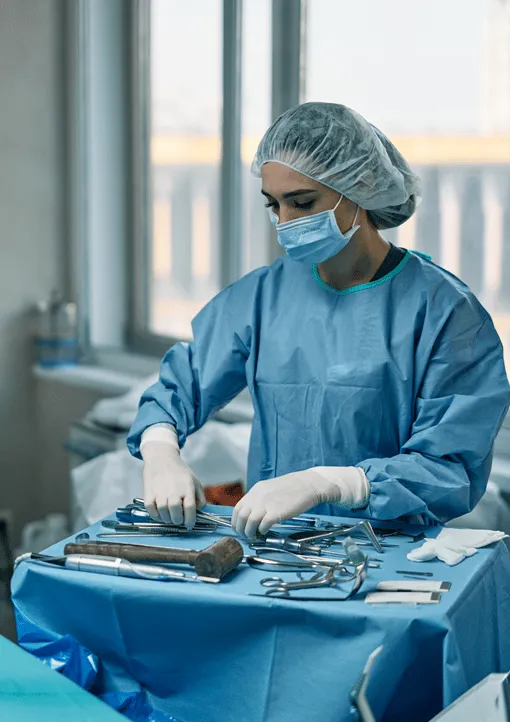Operating Room Staff Roles and Responsibilities (in the US)
Incision · · 10 min readEveryone of the surgical team holds a crucial staff role during the procedure in the operating room. The operating team members usually consist of sterile and unsterile divisions. The surgeon, assistants to the surgeon, and the scrub team are a part of the sterile division. As a part of the sterile division, you are required to perform surgical handwashing and wear sterile gloves, gowns, and masks. You are only authorized to handle sterile equipment and must remain in the sterile field area of the OR. The nurse anesthetist, anesthesiologist, circulating nurse, radiology technicians, medical device representative, and additional staff are a part of the non-sterile division. The operating room staff roles are coordinated amongst each other during the patient's surgery.

Operating Surgeon
The surgeon is a licensed professional who is responsible for the preoperative diagnosis and care of the patient. The surgeon performs surgical procedures that are used to diagnose, treat and repair the body. Surgeons are the captains of the operating room and ensure the procedure goes smoothly. They perform operations to treat a variety of diseases and illnesses such as broken bones, cancerous tumors, traumatic injuries, organ transplants, plastic surgery, infant delivery, etc. Surgeons often participate in co-surgeries with other surgeons to fix multiple issues surgically. These are called combo or joint case surgeries. Combo cases are done to prevent a patient from having to undergo multiple procedures and additional incisions. Joint cases can also lower the risk of surgical site infections. Anytime a patient has a surgical procedure they are at risk of infection. Once the surgery has been completed the surgeon provides postoperative management care for the patient for the duration of recovery. After obtaining a bachelor’s degree, surgeons generally go to medical school for 4 years and attain an additional 4 years of specialized residency training.
Surgical Assistants
There are usually one or two surgical assistants that perform a series of additional tasks under the direction of the operating surgeon. The surgical assistant may be another licensed surgeon, nurse practitioner, physician assistant, surgical resident who is currently enrolled in a surgical education program. With additional training, registered nurses, licensed practical nurses, and surgical technologists may also be first assists. If the medical student is in his last year of residency they are referred to as fellows. Surgeons may have their own personal designated operating room nurses, techs, and assistants. This team of qualified surgical personnel usually works in the same surgical specialty or with the same surgeon for many years and is more aware of applicable surgical preferences. Surgical assistants help with visibility of the surgical site, handling and using sterile instruments, inserting tubes, starting intravenous lines, bleeding control, closing the wound, and applying dressings.
Surgical Nurse (RN)
A surgical nurse has a major role within the operating room. Often they are referred to as an OR nurse, perioperative nurse, circulating nurse, or with additional training, an RN first assist. They may be called a scrub nurse if working in the scrub role. They work directly with all team members to maintain the safety and care of the patient in the OR and are often an advocate for the patient under anesthesia. They perform vital tasks before the surgery such as: preparing the room and sterile supplies for the surgical case, reviewing patient records, and setting up equipment/machines off the sterile field. Once the patient arrives, they identify and position the patient, prepare the surgical site, observe the team for breaks in sterile technique, anticipate needs of the team, document, and coordinate with professionals outside of the OR room. Registered nurses with advanced training may administer light to moderate sedation during procedures. The surgical nurse must have patience, vigilance, good decision-making skills, and have the ability to work under tremendous pressure. Becoming a surgical nurse (RN) is a very rewarding career and requires a two or four-year nursing degree along with specialized training once in the OR.
Surgical Technologist
A surgical technologist is also referred to as a surgical technician, scrub person, and scrub tech. Surgical technologists work with the entire team and specifically the surgeon, to prepare and hand instruments during the surgical procedure. They also work closely with the surgical RN to prepare the room, set up the sterile field and may help identify and position the patient or assist with the preparation of the surgical site. They are mainly responsible for setting up the surgical sterile field, safety, efficiency, and maintaining a sterile surgical field during the duration of the procedure. A surgical technologist program usually takes between 12 to 24 months to complete.
Physician Assistant (PA, PA-C, APA-C)
A physician assistant is someone who practices medicine under the direct supervision of a licensed provider. In many instances, they assist the surgeon during the procedure, as well as close the surgical wound and apply dressings or bandages. They may also assist in the transfer and positioning of the surgical patient. PAs were just recently renamed physician associates by the national licensing board AAPA. They assist with medical diagnosis, develop treatment plans, conduct physical examinations, prescribe medications, perform procedures and do clinical research. A PA may be the primary caregiver to patients and may see surgical patients for post-operative follow-up care. Their scope of practice varies by state, but in many medical settings, the PA provides treatment to their patient population. They practice in a variety of areas including hospitals, clinics, telemedicine, and other healthcare facilities. To become a physician’s assistant/associate, you must complete an undergraduate degree and have at least 3 years of clinical experience. Once these steps are taken you may then apply to an accredited PA program that takes about 26 months to complete.
Nurse Practitioner (NP)
A nurse practitioner is a registered nurse with advanced training and education. Their scope of practice varies by state. In some states, the NP has full practice authority while in others, the NP must have a physician sign-off on certain patient care decisions. In the OR, they function similarly to a PA. NP’s help with patient transfer and positioning, assist during the procedure, close wounds and apply dressings. They also see surgical patients for pre-operative and post-operative planning and care. An NP may be the primary care provider for general or specific patient populations, as many are certified in a specific patient population. They practice in most types of healthcare settings. To become a nurse practitioner, you must complete a master’s or doctoral degree beyond a registered nursing degree. Many advanced degree NP programs require you to have experience as a registered nurse prior to admittance.
Anesthesiologist
The anesthesiologists are the physicians who are responsible for developing anesthetic plans and administering the anesthesia. Their services are used before, during, and after a surgical procedure. Anesthesiologists may be trained in several different specialties of surgery including and not limited to cardiac, neuro, and orthopedics. They assist the patient with pain and critical care management. An anesthesiologist evaluates, supervises, and monitors the patient's care following the administration of anesthesia. Patients can receive a range of different types of anesthesia such as general, regional, local, and monitored or IV sedation. Before surgery, the anesthesiologist will conduct a detailed examination to determine any problems that may interfere with the administration of anesthesia. Once the anesthesiologist determines the requirements needed before, during, and after the procedure they will prepare a plan for a specific surgery. This plan helps to ensure that the surgery is safe and successful. During the surgery, the anesthesiologist manages your pain and vital body functions. If any unforeseen medical issues occur during the surgery, the anesthesiologist and surgeon work together to alleviate and resolve them. After the surgery has been completed the anesthesiologist helps to maintain breathing, level of oxygen, consciousness, and circulation throughout the body. They also work with the patient to manage pain after hospital discharge. Education requirements for an anesthesiologist consist of a bachelor’s degree, 4 years of medical school and 4 additional years of special anesthesia training. Additional training may be required depending on the specialty.
Nurse Anesthetist (CRNA)
The surgical team structure is very unique and involves many roles in the operating room. A nurse anesthetist provides an essential role before, during, and after a procedure. A CRNA may work under the supervision of an anesthesiologist or in autonomy, depending on the state where they practice. They are a part of the diagnosis, therapeutic and surgical components of surgery. Nurse anesthetists are involved in pre-anesthetic preparation, evaluation, induction maintenance, and post-anesthesia care. They also assist with providing continuous education, resource management, and quality assurance within their departments. CRNA’s are licensed to practice in several areas of the medical field including surgical, trauma, and obstetrics. To become a CRNA you must complete a 4-year undergraduate degree in nursing and also have experience as a nurse in an acute care setting. Nurses may then enter a 2-year doctorate program to complete their CRNA degree.

Radiology Technician (Rad Tech)
The role of the radiology tech is to provide intraoperative imaging for the surgeon during a procedure. They specialize in the diagnosis and treatment of patients using radiologic imaging. Rad techs are often called radiographers, radiologic technologists, x-ray technicians, and diagnostic radiographers. They provide a wide range of radiology equipment during surgery. For instance, many surgeons use C-Arm during various procedures. This equipment is brought in and operated by a radiology tech and used for fluoroscopic imaging and orthopedic procedures. A rad tech’s responsibility is to conduct imaging to guide the surgeon during a procedure.
Surgical Sales Representatives (Medical Device Representatives, MR)
Medical Device Representatives are individuals who sell and market medical equipment and other medical devices that are used in clinics and operating rooms. They are a very important component of the surgical process. Surgical Sales Reps bring a completely different role into the OR. Prior to entering a surgical procedure they often develop presentations for surgeons and other medical staff to introduce new medical products and services. They train surgeons and other hospital staff on all of the components and usage of surgical devices. Some surgical procedures require special equipment only for that particular procedure. During these special circumstances, a device sales rep is required to bring the needed equipment and may remain in the OR to guide the surgical team with usage. Medical device sales representatives typically have a degree in business or healthcare or have experience in the surgical environment.
Conclusion
Operating room staff roles are very important for any surgery to be efficient, safe, and successful. It takes a team of extraordinary individuals to come together like a symphony and become in sync with each other to perform amazing surgery procedures daily. Each one of their roles plays a crucial part in the surgical process that provides life longevity for patients. Several hours of research, documentation, and preparation are needed from the start to finish for these procedures. Playing a role in the operating room is an incredible and rewarding profession. At times it can be mentally and physically draining but the results of saving lives are such a wonderful sacrifice. Medical professionals are not always rewarded or given praise for their abilities to create, extend and mend patient lives. Patients are given more memories and years with their families because of the talented group of individuals in the OR. Life is precious and the roles that each individual plays in the operating room is the greatest gift to a patient in need of a life-saving surgical procedure.







